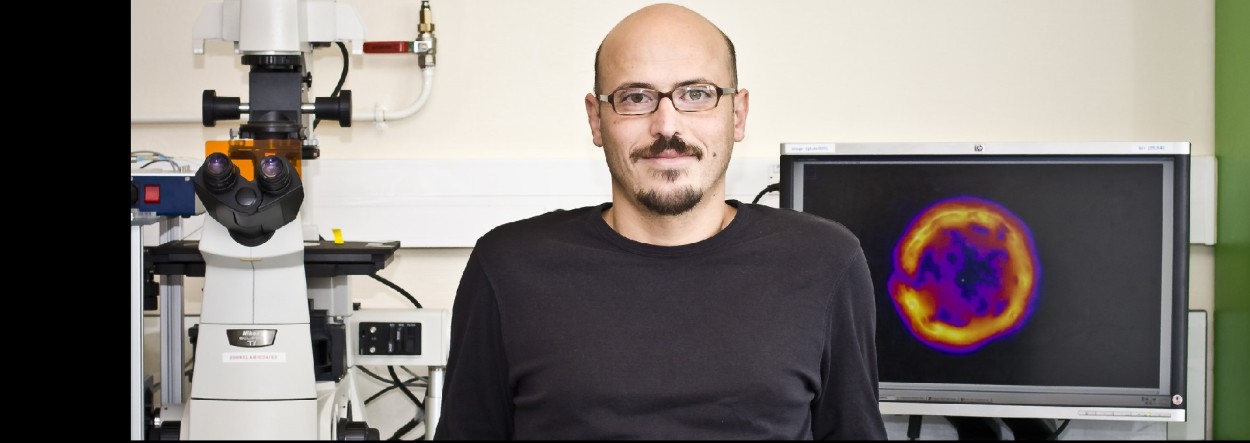When mechanics make cells talk

Over the past two decades, mechanobiology has shown that the mechanical constraints applied to our cells have an impact on their life and functioning. The research of Charles Baroud, professor at Ecole Polytechnique, is part of this dynamic. In particular, the LadHyX researcher is developing techniques for mechanically manipulating and probing very specific 3D cellular objects: spheroids (cellular aggregates mimicking tissues or tumors) and organoids (small cellular structures reproducing certain organ functions). This work opens the way to numerous applications and has now given rise to the Melcart (Mechanical Characterization and Stimulation of Microtissues) project, supported by an ERC Grants Advanced 2024 grant.
Mechanically stimulating cells
Over the last few years, the researcher and his team have confirmed their know-how in the cultivation of spheroids and organoids, to recreate living conditions as closely as possible in vitro (at the time, most studies were carried out on single cells or monolayer cell cultures). "We have also overcome a technological hurdle by creating a microfluidic device capable of exerting a forcing force on our cellular objects", says the researcher. Derived from soft robotics, the mechanism is made of a flexible polymer resembling the silicone used to seal windows. It enables a simple mechanical constraint (flattening from above) to be applied to the spheroids/organoids, and their deformation to be finely controlled via an air chamber system.
Although a 3D printer is all that's needed to build it, the device does not allow uniform (isotropic) stresses to be applied and gives no indication of the force exerted on the cellular objects. "With Melcart, we intend to improve this technology and succeed in applying isotropic forcing to our spheroids and organoids. We will also be perfecting our multi-scale cytometry techniques, i.e. the approaches we use to carry out biological or physical measurements on many cells", emphasizes the researcher.
Using image analysis systems, Charles Baroud can collect data at different scales of the spheroid or organoid, from the single cell to the entire object. "Microscopy is central to this aspect of the project. For a given forcing, certain cells in our 3D objects will compress, turn on themselves, or stretch. It's interesting to be able to determine the deformations undergone by each of them, but also by their various biological compartments (cytoplasm, nucleus, etc.) and thus establish a relationship between deformations and mechanical forces", he explains. At the same time, Melcart plans to develop specific algorithms to process, recontextualize and render more digestible the huge database generated by the collection of this information.
Mechanical response to characterize tissues
Melcart attempts to answer a number of questions, opening up new diagnostic and therapeutic perspectives: is it possible to determine the biological state of a tissue on the basis of its mechanical response (aggressiveness of a tumor, number of cancer cells it contains, etc.)? Is it possible to use mechanobiology to guide the development of biological tissues? As cardiac cells are extremely sensitive to mechanics, for example, the aim here is to use this lever to improve cardioid models and test the toxicity of certain molecules on cardiac muscle. "Other applications are conceivable in pharmacology. Can a given forcing, for example, differentially activate proteins and kill cancer cells while preserving healthy tissue cells? Personalized medicine is another possible application for Melcart. "Imagine a biopsy that is subjected to forcing. The reactions recorded are unique to the biopsy, and therefore to the patient. Treatment can then be provided in response to these characteristics".
Deeply multidisciplinary, Melcart is also conducive to synergies between fundamental research (the in-depth understanding of physical and biological phenomena) and applied research via its healthcare outlets and the engineering component aimed at developing new technologies. "This is one of the characteristics of LadHyX, but also what makes the project so rich," concludes the researcher.
* LadHyX : a joint research unit CNRS, École Polytechnique - Institut Polytechnique de Paris, 91120 Palaiseau, France
 Support l'X
Support l'X